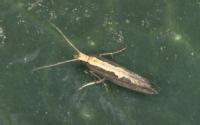Diamond-back moth 2016
In 2016 there was a very large migration of diamond-back moths, probably from continental Europe, which started at the end of May. Many millions of moths arrived in the UK and they were found in large numbers from south-west England to Orkney. Much of this activity was reported on Twitter https://twitter.com/MigrantMothUK. The moths may have arrived in several waves and it is likely that they laid eggs on host plants such as cabbage and cauliflower soon after their arrival. Eggs were found on horticultural brassicas and oil seed rape and there were many reports of caterpillar infestations, mainly on horticultural brassicas, in various parts of the UK. At Warwick Crop Centre we found infestations in a field trial on cabbage (estimate of approximately 8 larvae per plant on 24th June) and on some plants maintained in polytunnels.
Control measures
Because diamond-back moth has such a rapid life-cycle it is important to apply control measures in a timely fashion. This species has the potential to be resistant to almost all the insecticides available but this does not mean that the moths that have arrived in the UK are resistant to any of the insecticides approved for caterpillar control on brassicas in the UK. It depends where the moths originated and which pesticides they have been exposed to. The moths that arrived in 2016 were resistant to pyrethroid insecticides.
We had a large migration in 1996 (but probably not as large as this one). At the time, larvae in ongoing trials on brassica crops at Kirton showed no evidence of resistance to the insecticides available at the time – which were principally pyrethroids. Suitable insecticides available now include pyrethroids, spinosad, indoxacarb and Bt. It is obviously important to check approvals for particular crops. Field trials undertaken at Wellesbourne in the last few years indicate that plants treated with Verimark drenches for control of cabbage root fly should be able to withstand infestation by caterpillars if treated fairly recently.
If you have any evidence of the failure of a particular treatment to control an infestation please contact at Rothamsted Research.
Subsequent generations?
In 1996, the large migration in mid-June was followed by a subsequent generation (Figure 1). Figure 1 also shows how closely the capture of male moths in pheromone traps is aligned with egg-laying by female moths.
Figure 1 Numbers of moths, eggs and larvae in a brassica crop at Kirton, Lincolnshire in 1996

AHDB Project FV 440
AHDB project FV 440 investigated ways of managing pest migrant moths – silver Y moth and diamond-back moth and one aspect was the use of pheromone traps containing small cameras which allows growers to view captures by a network of pheromone traps remotely. We also investigated methods of control with new insecticides and biopesticides. In the same project Jason Chapman and colleagues at Rothamsted Research used weather data to track the origin of immigrant moths and this indicated that in 2016 our migrants came from Scandinavia.
Further information
Liu et al., (2002). Development and survival of the Diamondback Moth (Lepidoptera: Plutellidae) at constant and alternating temperatures. Environmental Entomology 31, 221-231.
Chapman JW, Reynolds DR, Smith AD, Riley JR, Pedgley DE and Woiwod IP (2002). High-altitude migration of the diamondback moth, Plutella xylostella, to the UK: a study using radar, aerial netting and ground trapping. Ecological Entomology 27: 641-650.
AHDB Project FV 440 - Lettuce and baby leaf salads: Investigation into control measures for Silver Y moth and caterpillars.
Some updates in 2016
Biological control of diamond-back moth
We collected 64 diamond-back moth pupae from some infested brassicas at Wellesbourne in late July 2016. From these 9 diamond-back moths and 17 adult parasitoids (wasps) have emerged so far!
1 September 2016
Trap captures at Wellesbourne suggest that a third generation may be on the wing now - but not in huge numbers.
15 July 2016
Migrant Alert! Warm south-easterlies forecast for Tuesday night, with a minimum temperature of 20oc in the south.
13 July 2016
It looks like a second generation of moths may be starting to emerge as emerging diamond-back moths have been noted by several moth recorders.
Adult diamond-back moth
Caterpillars and damage
Damaged plant
Moths captured in light trap June 2016
Moths captured in pheromone trap June 2016





